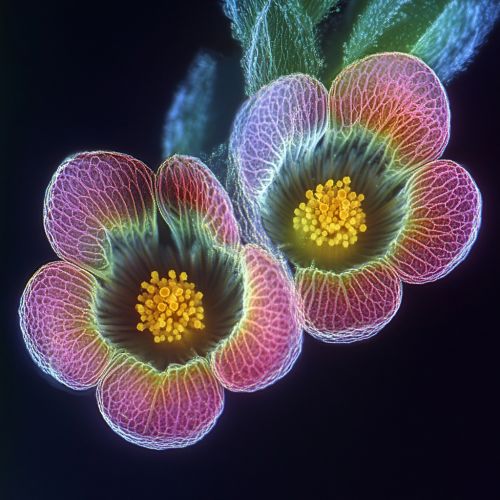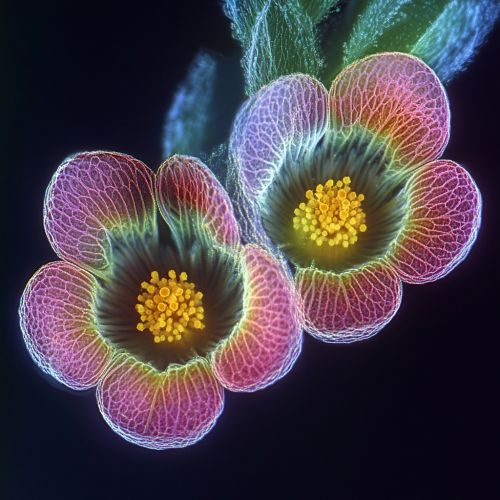Double fertilization: Difference between revisions
(Created page with "== Introduction == Double fertilization is a unique and complex fertilization mechanism found in angiosperms (flowering plants). This process involves the fusion of two sperm cells with different cells within the ovule, leading to the formation of both the zygote and the endosperm. Double fertilization is essential for the reproductive success of angiosperms and plays a crucial role in the development of seeds and fruits. == Historical Background == The phenomenon of do...") |
No edit summary |
||
| Line 17: | Line 17: | ||
One sperm cell fuses with the egg cell to form a diploid zygote, which will develop into the embryo. The other sperm cell fuses with the diploid central cell to form a triploid cell, which will develop into the endosperm. The endosperm provides nourishment to the developing embryo and is crucial for seed development. | One sperm cell fuses with the egg cell to form a diploid zygote, which will develop into the embryo. The other sperm cell fuses with the diploid central cell to form a triploid cell, which will develop into the endosperm. The endosperm provides nourishment to the developing embryo and is crucial for seed development. | ||
[[Image:Detail-97797.jpg|thumb|center|Microscopic view of double fertilization in a flowering plant.|class=only_on_mobile]] | |||
[[Image:Detail-97798.jpg|thumb|center|Microscopic view of double fertilization in a flowering plant.|class=only_on_desktop]] | |||
== Molecular and Genetic Regulation == | == Molecular and Genetic Regulation == | ||
Latest revision as of 13:11, 30 August 2024
Introduction
Double fertilization is a unique and complex fertilization mechanism found in angiosperms (flowering plants). This process involves the fusion of two sperm cells with different cells within the ovule, leading to the formation of both the zygote and the endosperm. Double fertilization is essential for the reproductive success of angiosperms and plays a crucial role in the development of seeds and fruits.
Historical Background
The phenomenon of double fertilization was first observed by Sergei Nawaschin and Léon Guignard in the late 19th century. Their pioneering work laid the foundation for our understanding of this intricate process. Subsequent research has elucidated the molecular and cellular mechanisms underlying double fertilization, highlighting its significance in plant reproduction and evolution.
Mechanism of Double Fertilization
Double fertilization involves several key steps, including pollen tube growth, sperm cell delivery, and the fusion of gametes. The process can be divided into the following stages:
Pollen Tube Growth
After pollination, the pollen grain germinates on the stigma and forms a pollen tube that grows through the style towards the ovule. The pollen tube is guided by chemical signals released by the ovule, ensuring accurate delivery of the sperm cells.
Sperm Cell Delivery
The pollen tube carries two non-motile sperm cells. Upon reaching the ovule, the pollen tube penetrates the synergid cells within the embryo sac, releasing the sperm cells into the vicinity of the egg cell and the central cell.
Fusion of Gametes
One sperm cell fuses with the egg cell to form a diploid zygote, which will develop into the embryo. The other sperm cell fuses with the diploid central cell to form a triploid cell, which will develop into the endosperm. The endosperm provides nourishment to the developing embryo and is crucial for seed development.


Molecular and Genetic Regulation
Double fertilization is tightly regulated by a complex network of molecular and genetic factors. Key players include:
Signaling Molecules
Chemical signals such as peptides, hormones, and small RNAs play critical roles in guiding the pollen tube and facilitating sperm cell fusion. For example, the peptide LURE is secreted by synergid cells to attract the pollen tube.
Gene Expression
Specific genes are activated during double fertilization to ensure the proper development of the zygote and endosperm. Genes such as FIS (Fertilization Independent Seed) and MEA (MEA Polycomb Group Protein) are involved in regulating endosperm development.
Epigenetic Modifications
Epigenetic changes, including DNA methylation and histone modifications, are crucial for the regulation of gene expression during double fertilization. These modifications ensure that the genetic information is accurately transmitted and expressed in the developing seed.
Evolutionary Significance
Double fertilization is a key innovation in the evolution of angiosperms. It provides several advantages, including:
Efficient Resource Allocation
The formation of the endosperm ensures that resources are efficiently allocated to the developing embryo, enhancing seed viability and success.
Genetic Diversity
Double fertilization promotes genetic diversity by combining the genetic material from two different gametes. This diversity is essential for the adaptation and survival of plant species in changing environments.
Coevolution with Pollinators
The evolution of double fertilization is closely linked to the coevolution of angiosperms with their pollinators. The intricate relationships between plants and pollinators have driven the diversification and success of flowering plants.
Applications in Agriculture and Biotechnology
Understanding double fertilization has significant implications for agriculture and biotechnology. Key applications include:
Crop Improvement
Knowledge of the genetic and molecular mechanisms underlying double fertilization can be harnessed to improve crop yields and quality. For example, manipulating genes involved in endosperm development can enhance seed size and nutrient content.
Hybrid Seed Production
Double fertilization is exploited in the production of hybrid seeds, which exhibit superior traits such as increased vigor and resistance to diseases. Techniques such as controlled pollination and genetic engineering are used to produce hybrid seeds.
Conservation of Plant Biodiversity
Studying double fertilization can aid in the conservation of plant biodiversity. Understanding the reproductive mechanisms of endangered plant species can inform conservation strategies and ensure their survival.
Challenges and Future Directions
Despite significant advances, several challenges remain in the study of double fertilization. Future research directions include:
Unraveling Molecular Pathways
Further research is needed to elucidate the complex molecular pathways involved in double fertilization. Advanced techniques such as CRISPR-Cas9 and single-cell RNA sequencing can provide insights into the regulatory networks.
Overcoming Fertilization Barriers
Understanding the mechanisms that prevent cross-species fertilization can aid in overcoming barriers to hybridization. This knowledge can be applied to develop new crop varieties with desirable traits.
Climate Change Adaptation
Investigating how double fertilization is affected by climate change can inform strategies to develop crops that are resilient to changing environmental conditions.
Conclusion
Double fertilization is a fundamental process in the reproductive biology of angiosperms. It involves the fusion of two sperm cells with different cells within the ovule, leading to the formation of both the zygote and the endosperm. This process is tightly regulated by a complex network of molecular and genetic factors and has significant implications for plant evolution, agriculture, and biotechnology. Continued research in this field will enhance our understanding of plant reproduction and contribute to the development of sustainable agricultural practices.
